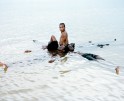Soft Mirror at RULE Gallery
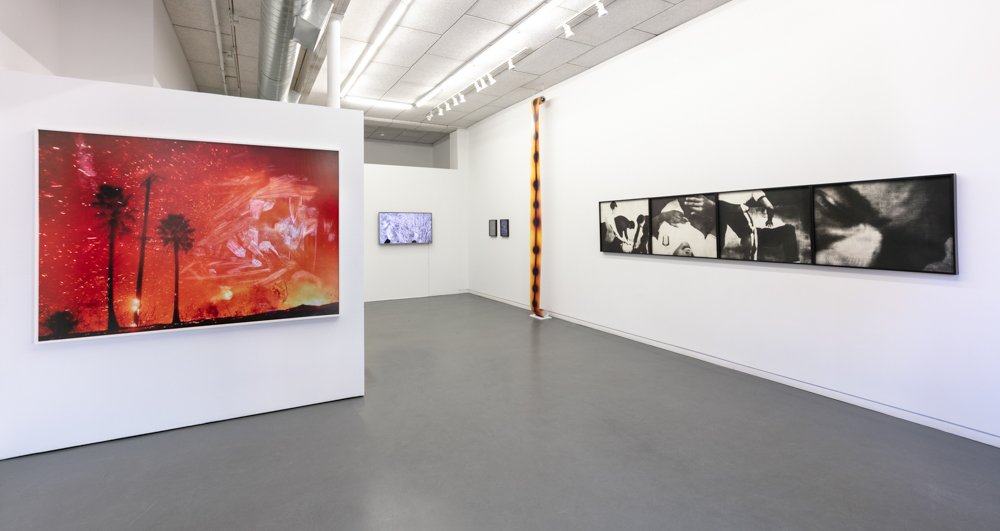
Installation view of Soft Mirror, RULE Gallery, Denver, CO, image courtesy of Wes Magyar
In his seminal 1978 publication Mirrors and Windows, critic and curator John Szarkowski suggested that photographs fall into two categories: mirrors reflecting a portrait of the artist who made it, and windows through which one may better know the world. The photographs in RULE Gallery’s Soft Mirror exist somewhere in-between, flattening time and distance to create portals that both reflect their makers and the lived experiences that shape their perspectives while also revealing that which exists beyond it.
In the exhibition, guest curator Britland Tracy brings together artists Kei Ito, Dionne Lee, Rafael Soldi, and Tabitha Soren to investigate the power dynamics embedded in our personal and cultural histories. In each, rituals become tools for exploration or liberation. Some take the form of solemn ceremonies, ancestral practices, or rites of passage; others are simply born out of convention or habit.
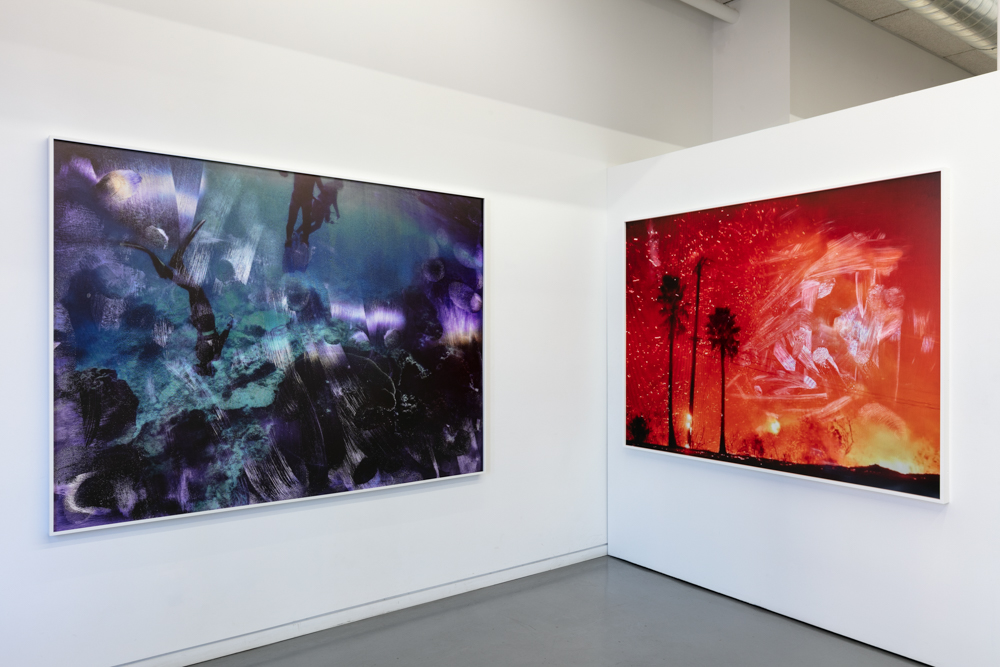
Installation view of Soft Mirror, RULE Gallery, Denver, CO, image courtesy of Wes Magya
Soft Mirror begins with two vibrantly colored large-scale photographs from Tabitha Soren’s Surface Tension. Using her own encounters with mass media as a starting point, Soren rephotographs online images of natural disasters and political unrest to explore the cultural phenomenon of “doom scrolling” through social media and the news. One of these images documents wild fires in California; the other comes from a news article about the negative impacts of tourism on the great barrier reef. A third photograph in the back of the gallery was taken at a political protest.

© Tabitha Soren, theguardian.com/tourists_change_great_barrier_reef_for_ever, 2018, archival pigment print
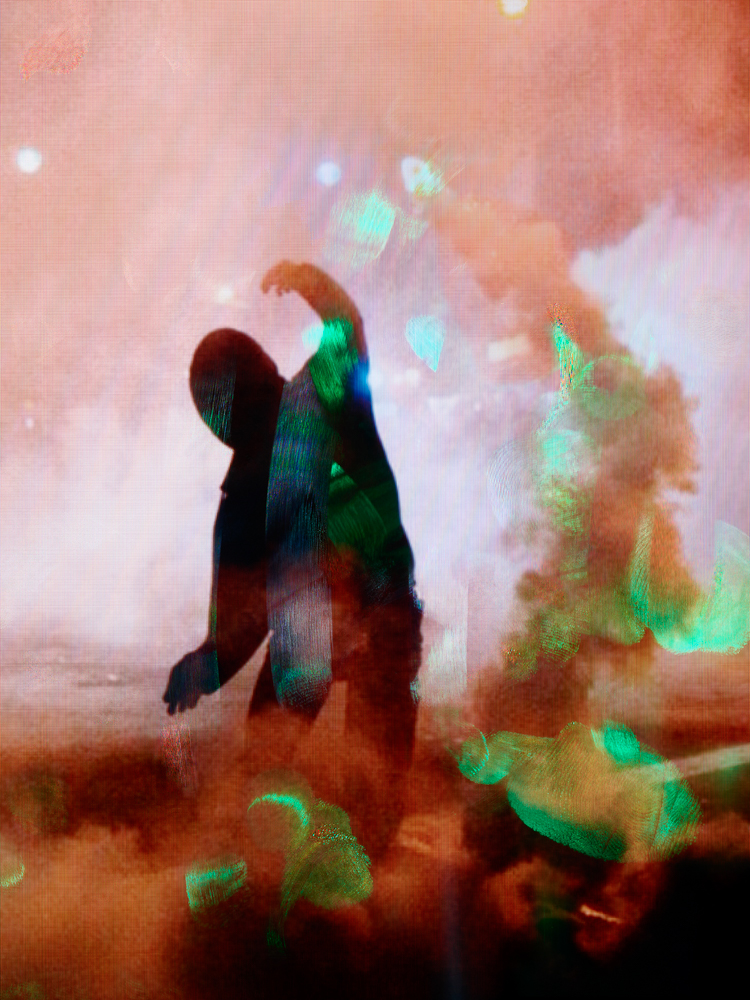
© Tabitha Soren, facebook.com/kathleenwedgworth.reed/tear-gas-on-oakland-protesters-demonstration-declared-unlawful-assembly/, 2019, archival pigment print
Titles like facebook.com/kathleenwedgworth.reed/tear-gas-on-oakland-protesters-demonstration-declared-unlawful-assembly/ make it clear where these images originally came from. Visually, their content is somewhat obscured as the artist focuses the lens of her 8×10 film camera on the illuminated screen of her iPad, smeared with fingerprints and smudged debris, instead of the image it displays. The resulting artworks are lush landscapes of physical touch- visceral, intimate, and undeniably beautiful. Foregrounding the residue of her interaction with these images of disaster, Soren’s painterly photographs reveal “the artist’s hand” in a compelling indictment of our role – not as passive spectators, but active participants – in a compulsive ritual that blurs the line between violence and entertainment.

© Rafael Soldi, Cargamontón (image two in a portfolio of 8 images), 2021, Aquatint Photogravures
The intimacy of physical touch is also a key element of artist Rafael Soldi’s reflections on his experience growing up as a queer youth in Latin America. Isolating scenes from found video footage of Cargamontón—a common rite of passage in which adolescent boys humiliate and smother each other to assert dominance and power—Soldi reveals unintentionally erotic moments that vacillate between pain and pleasure, subjugation and liberation. The original videos were posted to the Internet in the early 2000s by Perúvian teens seeking to immortalize these displays of masculinity. Their low resolution imbue the images with the hazy and fragmented quality of memory as the blurred figures serve as surrogates for Soldi’s own experience enduring this violent ritual at an all boys Catholic school. The black and white still images feel chaotic and disorienting in a way that resonates with the inherent confusion and uncertainty of navigating social norms as an adolescent. They are displayed in a continuous row like frames of a movie, reinforcing the idea that these extracted moments remain part of a larger narrative about masculinity, sexuality, and intimacy.
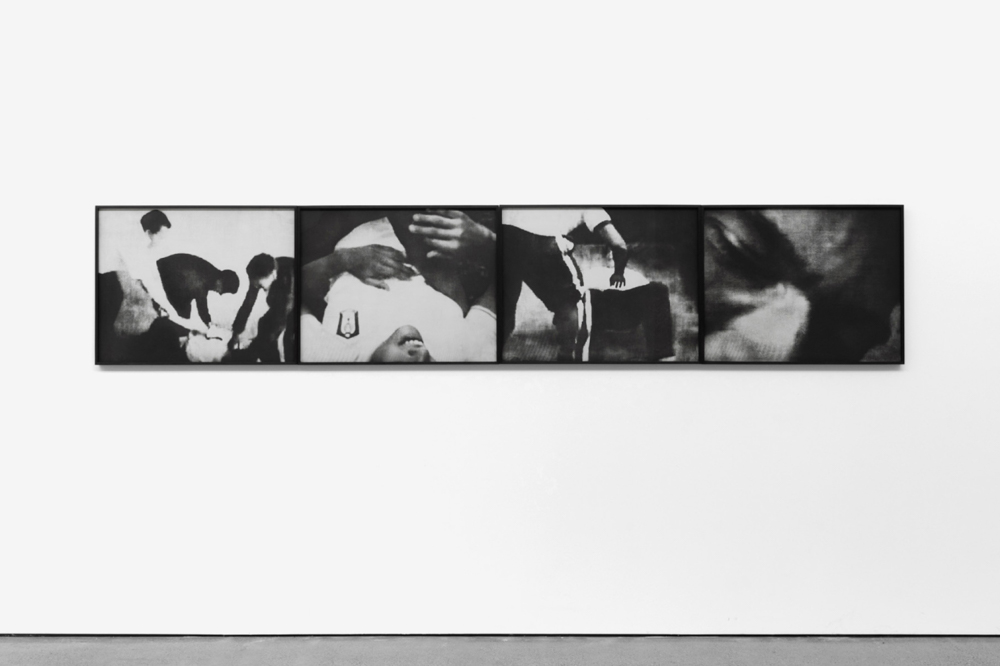
© Rafael Soldi, Cargamontón, 2021, Aquatint Photogravures

© Rafael Soldi, Cargamontón (image one in a portfolio of 8 images), 2021, Aquatint Photogravures
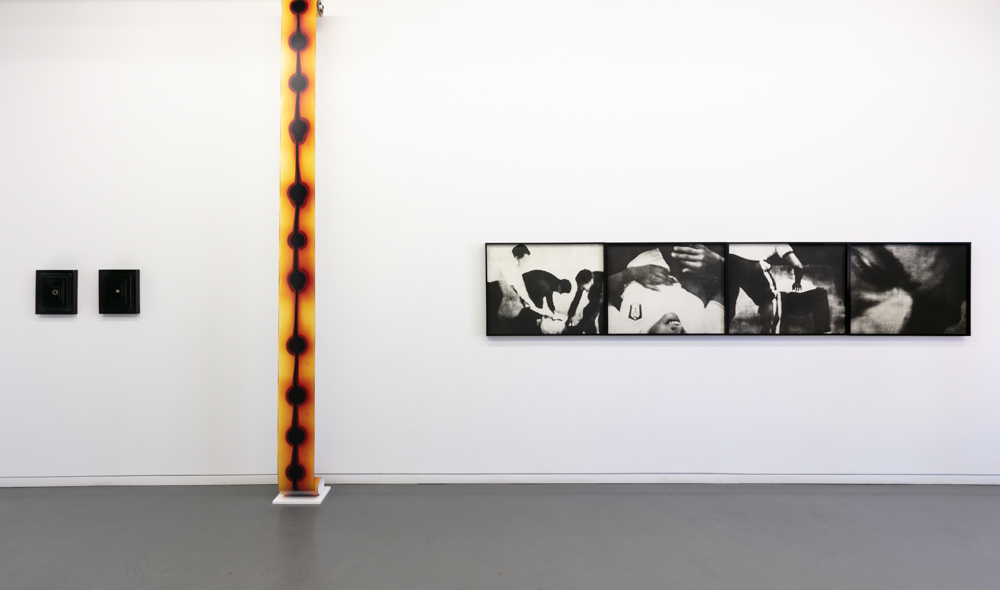
Installation view of Soft Mirror, RULE Gallery, Denver, CO, image courtesy of Wes Magyar
Perhaps one of the most impactful artworks in the exhibition is Kei Ito’s Sungazing Scroll: 2019, a ninety-five-foot-long photogram hung from the ceiling and spilling onto the floor in the middle of the gallery. The grandson of a Hiroshima bombing survivor, Ito creates a scroll each year to reflect on the impact of that tragic event his grandfather described as “a hundred suns lighting up the sky.” In this annual ritual, Ito exposes light sensitive paper to the sun to record 108 breaths representing the 108 bell tolls that mark the arrival of the Japanese New Year. Using his body as a conduit, each inhale becomes a vivid explosion of color and light, transforming a hundred suns from a symbol of destruction into an expression of resilience and renewal. Despite its loud color palette and graphic composition, this work emanates a sense of calm. The artist’s breath is steady and even, lending rhythm and balance to the abstract pattern it imprints onto the paper.
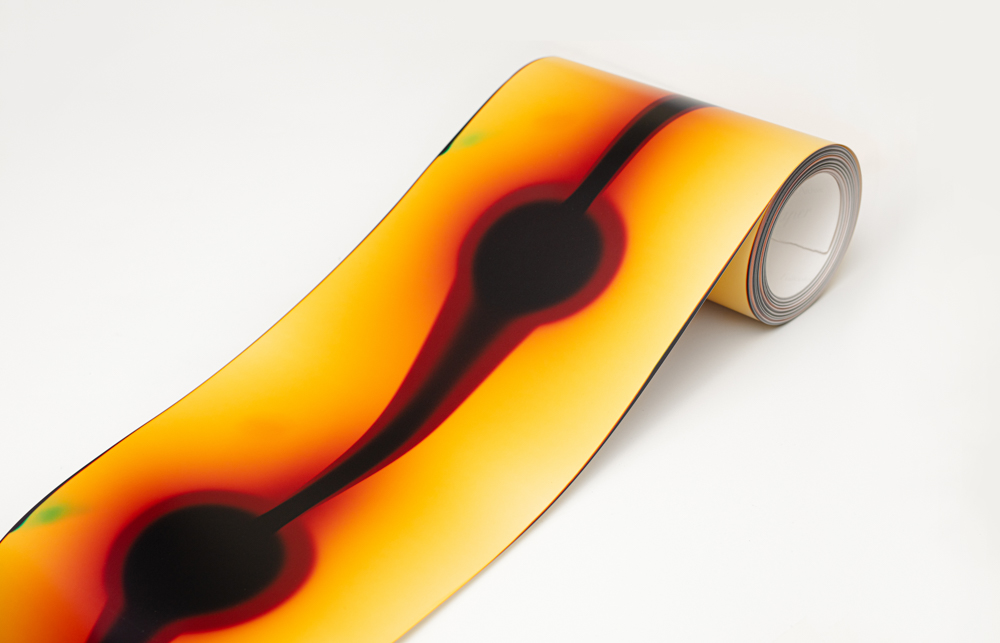
© Kei Ito, Sungazing Scroll: 2019, 2019, Unique C-print photogram Scroll (Sunlight, Artist’s breath)
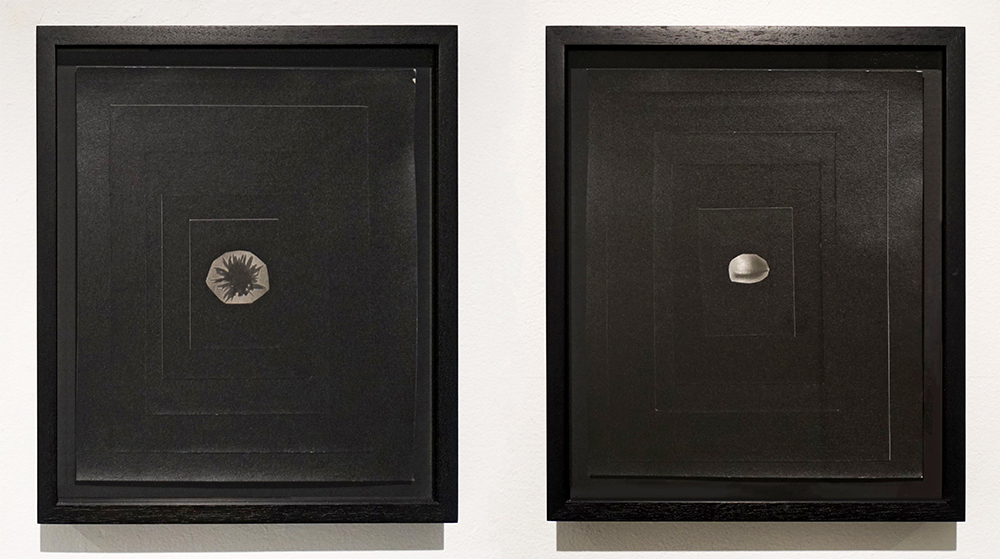
© Dionne Lee, right: Mound, 2022, gelatin silver print, collage; left: Ditch, 2022, gelatin silver print, collage
Soft Mirror concludes with four works by artist Dionne Lee, who employs a range of mediums to excavate the hidden and often violent histories embedded in the American landscape. In Ditch and Mound, a pair of small silver gelatin collages, images of a single closed eye and a flower rest on top of layers of black paper like metaphorical burial sites, conjuring thoughts of death and regeneration. In Lee’s quiet, monochromatic videos, the viewer shares the artist’s point of view as she performs ancestral practices of way-finding and water divination to navigate her environment. In all of her works, the earth becomes an activated stage for the artist to perform and reflect on our relationship to the land. They resist the erasure of the complicated histories often seen in representations of the American landscape, suggesting that while the land is not a blank slate, it is still full of potential.
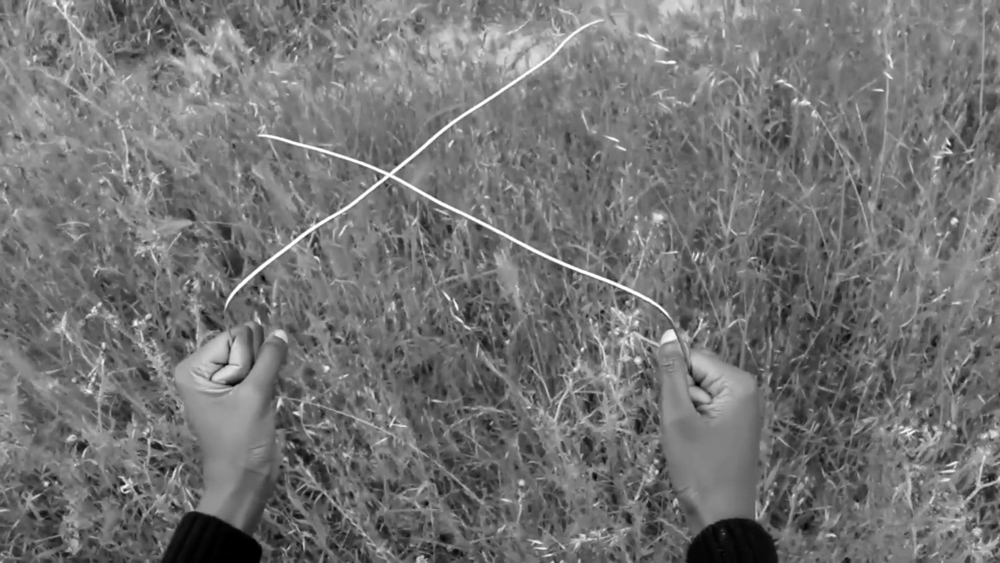
© Dionne Lee, Challenger Deep, 2019, single channel video
About the Artists:
Kei Ito (b. 1991, Tokyo, Japan) is a visual artist working primarily with installation art and photographic-media who is currently teaching at the International Center of Photography (ICP) in NYC. Ito received his BFA from the Rochester Institute of Technology and his MFA from the Maryland Institute College of Art. Ito has participated in numerous Artist in Residence programs including the Studio at MASS MoCA(2021), the Denis Roussel Fellowship at the Center for Fine Art Photography (2021), and the Center for Photography at Woodstock (2019). His internationally recognized solo and group exhibitions can be read in reviews and articles published by the Washington Post, Hyperallergic, BmoreArt, ArtMaze Magazine, and BBC Culture & Art. His works are included in major institutional collections such as the Museum of Contemporary Photography, the Norton Museum of Art, Chroma at California Institute of Integral Studies, and the Eskenazi Museum of Art. He currently lives and works in Baltimore, MD.
Follow Kei Ito on Instagram: @kei.ito.art
Dionne Lee (b. NY, New York) works in photography, collage, and video to explore issues of power, survival, and personal history in relation to the American landscape. She received her MFA from California College of the Arts in 2017 where she won the Barclay Simpson Award and Graduate Fellowship at Anderson Ranch Arts Center. She has exhibited at the Museum of Modern Art, Yancey Richardson, and Aperture Foundation in New York City; New Orleans Museum of Art; Silver Eye Center for Photography, Pittsburgh, PA; Et Al., Oakland, CA; and the San Francisco Arts Commission, among others. Lee has been an Artist-in-Residence at Light Work in Syracuse, NY, The Chinati Foundation in Marfa, TX, and at Unseen California. Lee is currently a Post-MFA Fellow at The Ohio State University and living on the unceded territories of the Shawnee, Potawatomi, Delaware, Miami, Peoria, Seneca, Wyandotte, Ojibwe and Cherokee peoples.
Follow Dionne Lee on Instagram: @itsdionne
Rafael Soldi is a Peruvian-born, Seattle-based artist and curator. He holds a BFA in Photography & Curatorial Studies from the Maryland Institute College of Art. His practice centers on how queerness and masculinity intersect with larger topics of our time such as immigration, memory, and loss. He has exhibited internationally at the Frye Art Museum, American University Museum, Griffin Museum of Photography, CLAMP, The Print Center, Museo MATE, Filter Space, and Burrard Arts Foundation, among others. Rafael has received grants and awards from the Magenta Foundation, Puffin Foundation, smART Ventures, Artist Trust, 4Culture, the Seattle Office of Arts & Culture, and Center Santa Fe. He has been awarded fellowships at MacDowell, Bogliasco Foundation, Vermont Studio Center, and PICTURE BERLIN. His work is in the permanent collections of the Museum of Fine Arts, Houston; Tacoma Art Museum; Frye Art Museum; and the Pennsylvania Academy of Fine Arts. Rafael’s work has been reviewed on ARTFORUM, The Seattle Times, The Boston Globe, Photograph Magazine, The Seen, Art Nexus, and PDN. He is the co-founder of the Strange Fire Collective, a project dedicated to highlighting work made by women, people of color, and queer and trans artists; and co-curator of the High Wall, a yearly outdoor video projection program that invites immigrant artists and artists working on themes of diaspora and borderlands to intervene the facade of a former immigration center building in the heart of Seattle.
Follow Rafael Soldi on Instagram: @rafaelsoldi
Tabitha Soren was born in 1967 in San Antonio, Texas and lived in 7 U.S. states, Germany and the Philippines during her formative and adolescent years. Her work explores the expansive power of photography by pushing its material limits and embracing its unreliable nature. She probes the surface of the photograph to unlock the rich history of the medium and experiments with sculptural and painterly interventions to further complicate the inherent uncertainty of the source. This layered approach underscores not only the bounds of the viewer’s perception but also makes visible the psychological states of Soren’s subject matter, creating a tension between what is seen and what lies underneath. Soren received her degree in 1989 from New York University and was awarded a fellowship from Stanford University in 1997. Her work is in many private and public collections including the Los Angeles County Museum of Art, CA; The Cleveland Museum of Art, OH; The New Orleans Museum of Art, LA; Harvard Art Museums, Cambridge, MA; The High Museum, Atlanta, GA; the Oakland Museum of California; The George Eastman Museum, Rochester, NY; The Berkeley Art Museum and Pacific Film Archive, CA; Pier 24 Photography, San Francisco, CA; and The J. Paul Getty Museum, Los Angeles, CA. Her images have been featured in The New Yorker, The Atlantic, Garage, Hyperallergic, the Washington Post, California Sunday Magazine, ArtNews, Newsweek, and the Guardian, and publications include Fantasy Life (Aperture), Trace (Yoffy Press) and Surface Tension (RVB Books). She currently lives and works in San Francisco, California.
Follow Tabitha Soren on Instagram: @tabithasoren
About the Curator:
Britland Tracy is an artist and educator from the Pacific Northwest whose work engages photography, text, and ephemera to observe and transform infrastructures of human connection and discord. She has published two artist books, Show Me Yours and Pardon My Creep, and exhibited at the Griffin Museum of Photography in Winchester, MA, Davis Orton Gallery in Hudson, NY, Rule Gallery in Marfa, TX, Redline Contemporary Art Center in Denver, CO, the Lucie Foundation in Los Angeles, CA, the Photographic Center Northwest in Seattle, WA, the CU Art Museum in Boulder, CO, and a number of other experimental and collaborative spaces. She holds a BA in French from the University of Washington, a Certificate in Fine Art Photography from the Photographic Center Northwest, and an MFA in Interdisciplinary Media Arts Practices from the University of Colorado, where she continues to teach remotely while living and making in Marfa, Texas.
Follow Britland Tracy on Instagram: @britlandtracy
About the Gallery:
RULE Gallery, founded in 1991, has locations in Denver, CO and Marfa, TX. RULE represents emerging and mid-career contemporary artists and artist estates, with a focus on fostering investigative art practices while developing artists’ long-term careers. Outside their robust in-house exhibition schedule, RULE coordinates programming in prominent institutions and non-traditional settings, expanding community engagement with the work. In addition, the gallery actively endeavors to bring greater recognition of the region’s historic art movements to a broader audience.
Follow RULE Gallery on Instagram: @rulegallery
Posts on Lenscratch may not be reproduced without the permission of the Lenscratch staff and the photographer.
Recommended
-
Arnold Newman Prize: C. Rose Smith: Scenes of Self: Redressing PatriarchyNovember 24th, 2025
-
The Aline Smithson Next Generation Award: Emilene OrozcoNovember 21st, 2025
-
MATERNAL LEGACIES: OUR MOTHERS OURSELVES EXHIBITIONNovember 20th, 2025
-
Josh Aronson: Florida BoysNovember 1st, 2025
-
Robert Rauschenberg at Gemini G.E.LOctober 18th, 2025




